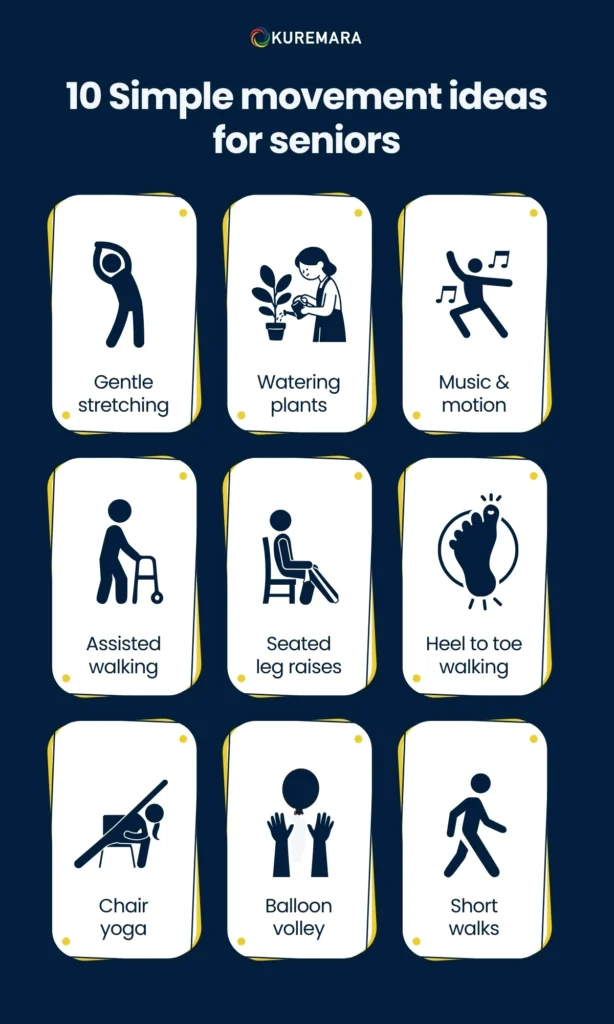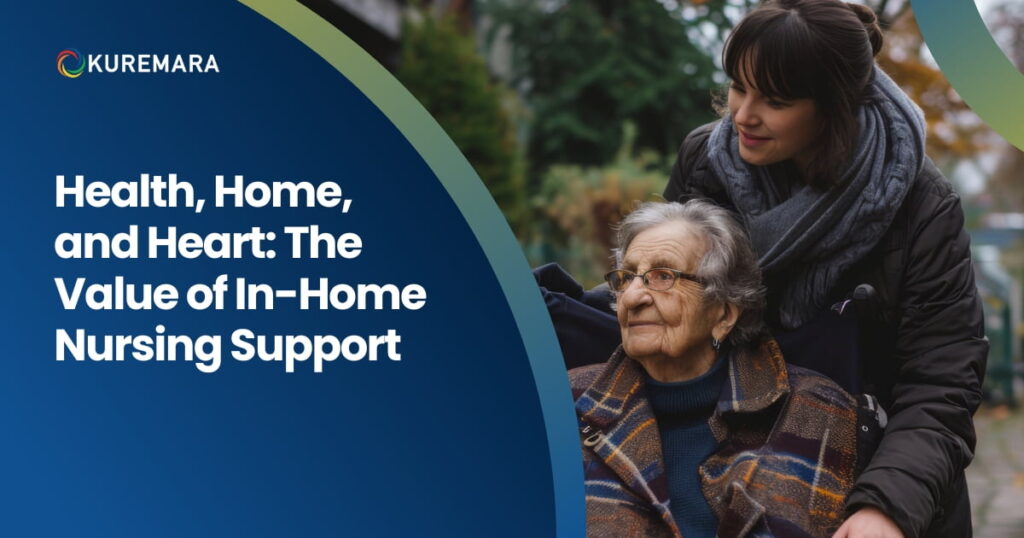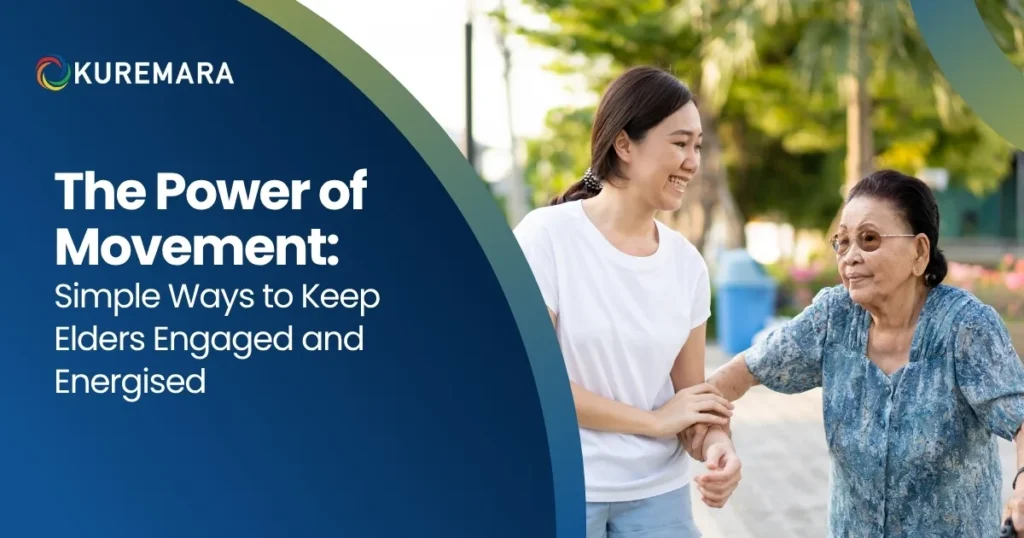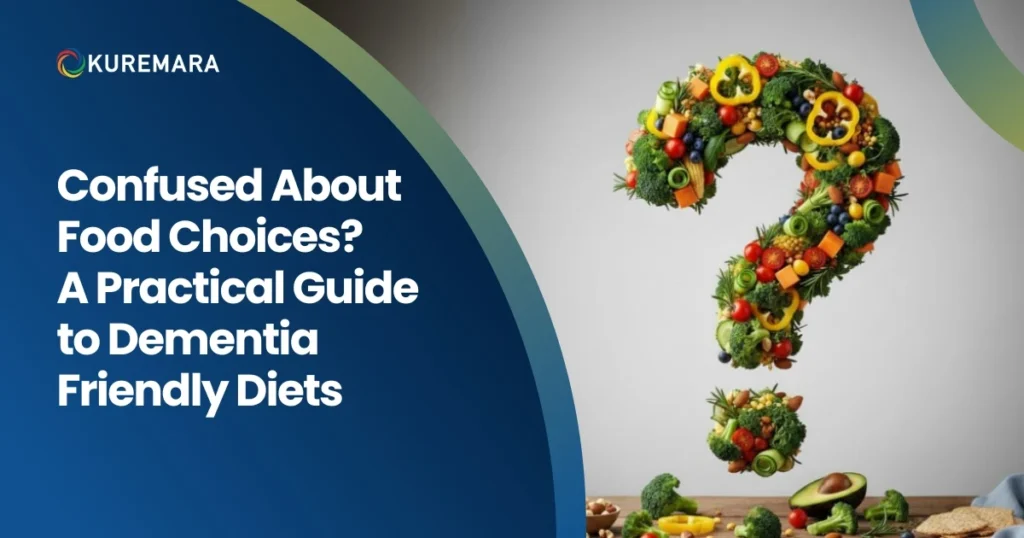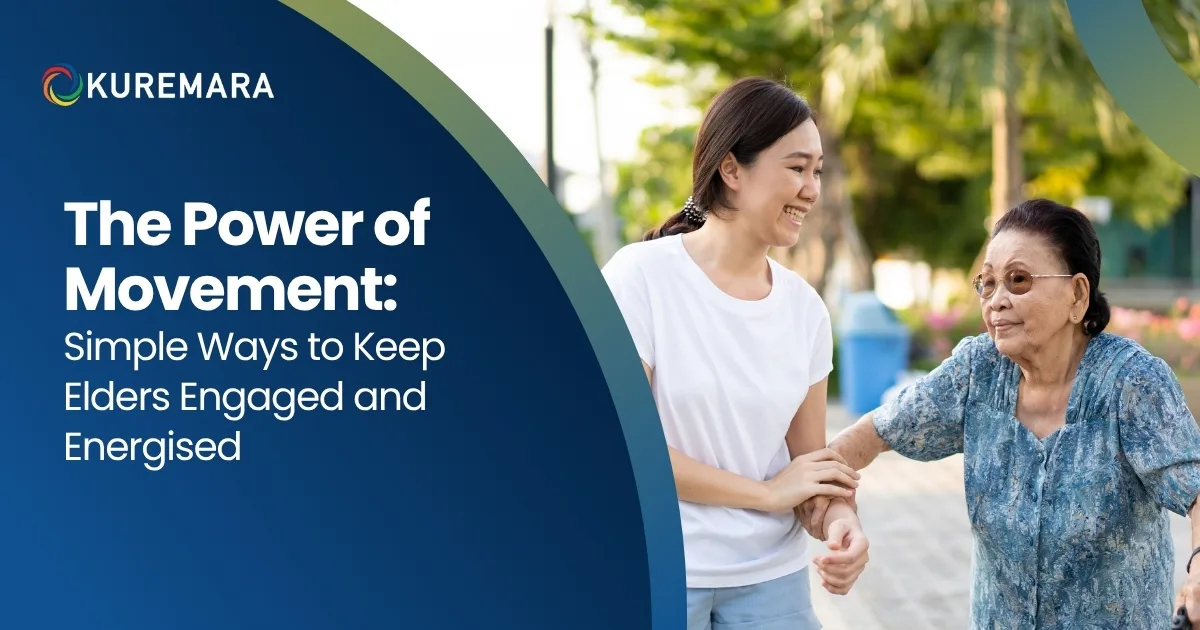
The Power of Movement: Simple Ways to Keep Elders Engaged and Energised
As age advances, it’s common for older adults to feel less motivated to move. Yet movement, even gentle motion is one of the most powerful tools to maintain dignity, independence, and wellbeing. At Kuremara, we believe that care is more than supporting day-to-day tasks; it’s about helping loved ones stay physically, mentally, and emotionally active through tailored care programmes.
In this article, you’ll discover how movement supports ageing, easy ways to encourage physical activity at home, how caregivers (including ours) make a difference, and how Kuremara’s services (hourly visiting, complex in-home care, respite care, live-in care) support movement in a safe, person-centred way.
Why Movement Matters in Later Life
1. Physical Health Benefits
- The UK’s physical activity guidelines recommend that older adults aim to accumulate at least 150 minutes of moderate intensity activity per week, ideally in bouts of 10 minutes or more. (Source: GOV UK)
- For those at risk of falls, balance and coordination exercises on at least two days a week are strongly advised.
- Movement helps preserve muscle strength, joint flexibility, cardiovascular health, and reduces risks of chronic conditions like arthritis, hypertension, diabetes, and osteoporosis.
- Conversely, extended sedentary behaviour is associated with negative outcomes (higher risk of obesity, metabolic disease, reduced mobility); the NHS warns us to “reduce sitting time” and break up long periods of inactivity.
2. Mental, Emotional & Cognitive Wellbeing
- Movement stimulates endorphins and supports emotional health, something especially important to counter isolation, depression, or low motivation.
- There is growing evidence that regular physical activity correlates with improved memory, cognitive processing, and delay of cognitive decline. (Source: PMC)
- Engaging in movement-based games, rhythmic motion, or group activity adds meaning, social connection, and joy to daily life.
3. The Context: Rising Need and Opportunity
- The UK’s older population is growing in 2024, 2 million people aged 65+ were estimated to have unmet care needs. (Source: Age UK)
- Around 42 % of people aged 55 and over are classed as inactive (vs. 29 % of the general adult population) in England. (Source: Sport England)
- However, positive trends are emerging: a 2024 report found 62.3 % of people aged 55–74 met the 150-minute-a-week target, and even in over-75s the figure rose to 42.8 %. (Source: The Guardian)
- These trends underscore that with encouragement, many older adults can increase their movement, and caregivers have a key role to play.
Overcoming Barriers to Staying Active
While the benefits are clear, older adults face real obstacles. Here’s how they arise and how thoughtful care can help:
| Barrier | How It Manifests | How Caregivers (and Kuremara) Can Help |
| Limited mobility, pain, or chronic conditions | Joint stiffness, fear of discomfort or injury | Use gentle, assisted movements; consult physiotherapists; adapt according to capability |
| Fear of falling or injury | Hesitancy to stand, walk, or try new movements | Supervision, clear safety protocols, use of grab rails or mobility aids |
| Lack of motivation or emotional barriers | Low confidence, depression, monotony | Set small achievable goals, track progress, provide encouragement, social engagement |
| Environmental constraints | Cluttered spaces, insufficient supports | Modify the home for safe movement, create a movement-friendly environment |
| Caregiver uncertainty | Unsure how much or what kinds of movement to encourage | Training, guidelines, and collaboration with clinical professionals |
At Kuremara, our care staff are trained to tailor movement plans to each individual’s capacity not “one-size-fits-all” and to monitor progress closely, ensuring safety and gradual growth.
Simple Daily Movement Ideas for Older Adults
Here are movement suggestions tailored by common care settings. Choose what suits best for each individual and build gradually.
a. For Hourly Visiting Care Clients
These are brief but impactful activities that visiting carers can incorporate into their sessions:
- Gentle morning stretching routines (neck turns, shoulder rolls, ankle circles).
- Encouraging small tasks (watering indoor plants, folding laundry) to promote purposeful movement.
- “Music and motion” sessions dance or mimic simple arm/leg movements to favourite songs.
- Assisted walking for a few minutes, indoors or outdoors, tracked by steps or distance.
b. For Clients Requiring Complex In-Home Care
For those with more significant needs, safe but more structured movement is possible, under supervision:
- Adaptive exercises: seated leg raises, gentle resistance band work, handgrip exercises.
- Balance and coordination work e.g. heel-to-toe walking, side steps, seated toe taps.
- Use of assistive devices (walking frames, handrails) to facilitate safe movement.
- Short intervals of standing up from a chair repeatedly (if mobility allows).
c. For Respite & Live-In Care Scenarios
These clients may benefit from more continuous support and monitoring of movement:
- Short outdoor walks (if feasible), even around the garden or courtyard.
- Chair yoga or seated stretching sequences.
- Light “movement games” tossing a soft ball, balloon volley, tai chi basics.
- Inclusive household tasks: folding towels, setting tables, light dusting chosen to be meaningful and manageable.
- Movement during social time e.g. music + gentle dance, movement-based memory games.
How Kuremara Carers Support Active Living
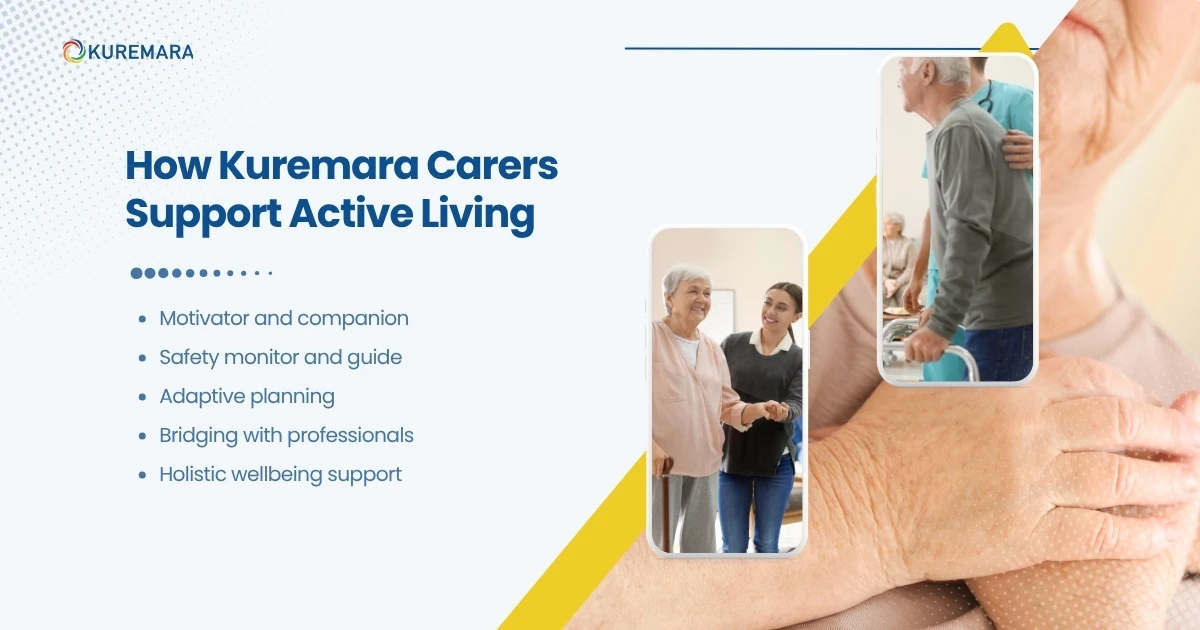
Movement is more sustainable and safer when integrated into daily care routines. Here’s how Kuremara’s carers play a pivotal role:
1. Motivator and companion
a. Carers don’t just assist; they provide encouragement, companionship, and accountability.
b. They can keep movement logs or charts, note improvements, and celebrate progress.
2. Safety monitor and guide
a. They ensure the environment is safe (no trip hazards, clear floor space) and supervise movement.
b. They adjust exercises based on health fluctuations (pain, fatigue, medical conditions).
3. Adaptive planning
a. Through person-centred care plans, Kuremara customises movement routines aligned with each client’s needs, mobility level, and preferences.
b. In live-in care, carers can more readily embed movement across the day; in hourly visiting care, they optimize shorter windows for impactful engagement.
4. Bridging with professionals
a. Carers coordinate with physiotherapists, occupational therapists or GPs to implement safe and effective movement strategies.
b. They feedback observations (e.g. gait changes, pain, mobility) to update the care plan.
5. Holistic wellbeing support
a. Beyond movement, carers support hydration, nutrition, rest, and emotional health all of which influence energy and willingness to move.
By making movement a regular, supported part of care, Kuremara helps older adults retain independence, reduce decline, and enhance quality of life.
Setting Up a Movement-Friendly Home
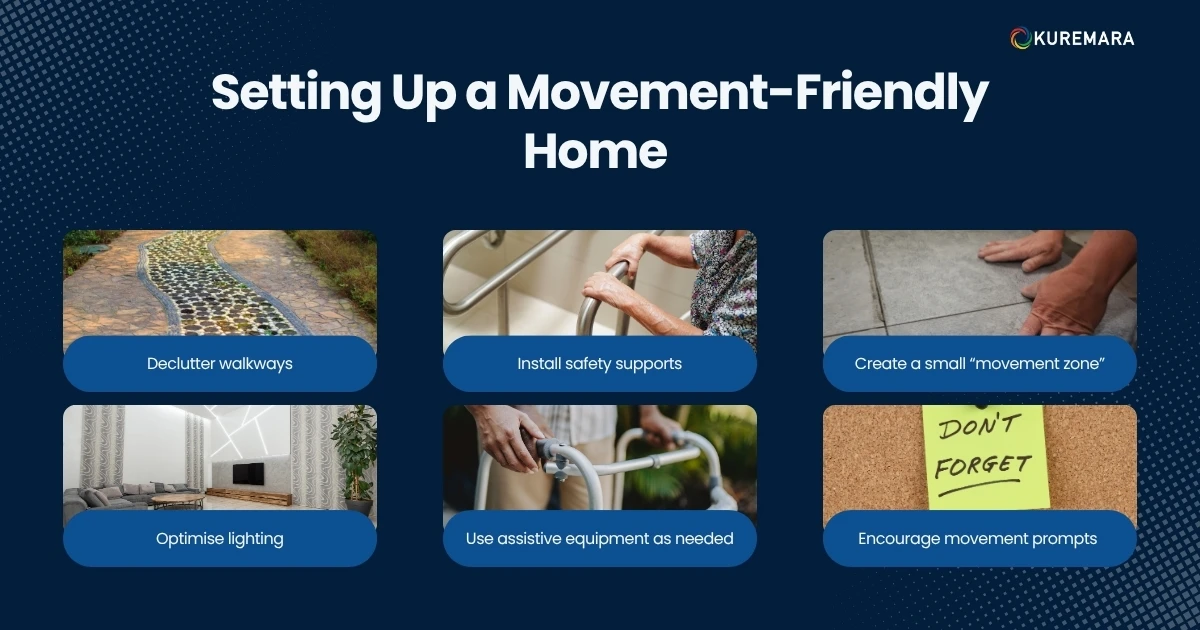
The right environment can make or break motivation. Here are tips to create a space where movement is encouraged:
- Declutter walkways – keep floors clear, remove loose rugs or obstacles.
- Install safety supports – grab rails, handrails, non-slip flooring, low thresholds.
- Create a small “movement zone” – designate a corner with supportive seating, resistance bands, light weights, or space for seated exercises.
- Optimize lighting – good lighting reduces fear and improves confidence during movement.
- Use assistive equipment as needed – walkers, seated bands, stability balls chosen per client’s capabilities.
- Encourage movement prompts – visual or written reminders (e.g. “stand up everyv 30 minutes,” cue cards) placed in frequent spots (kitchen, sitting room).
These modifications help reduce excuses and make movement easier, safer, and more likely to occur.
Nutrition, Rest & Movement: The Supporting Trio
Movement is more sustainable when paired with good nutrition and rest.
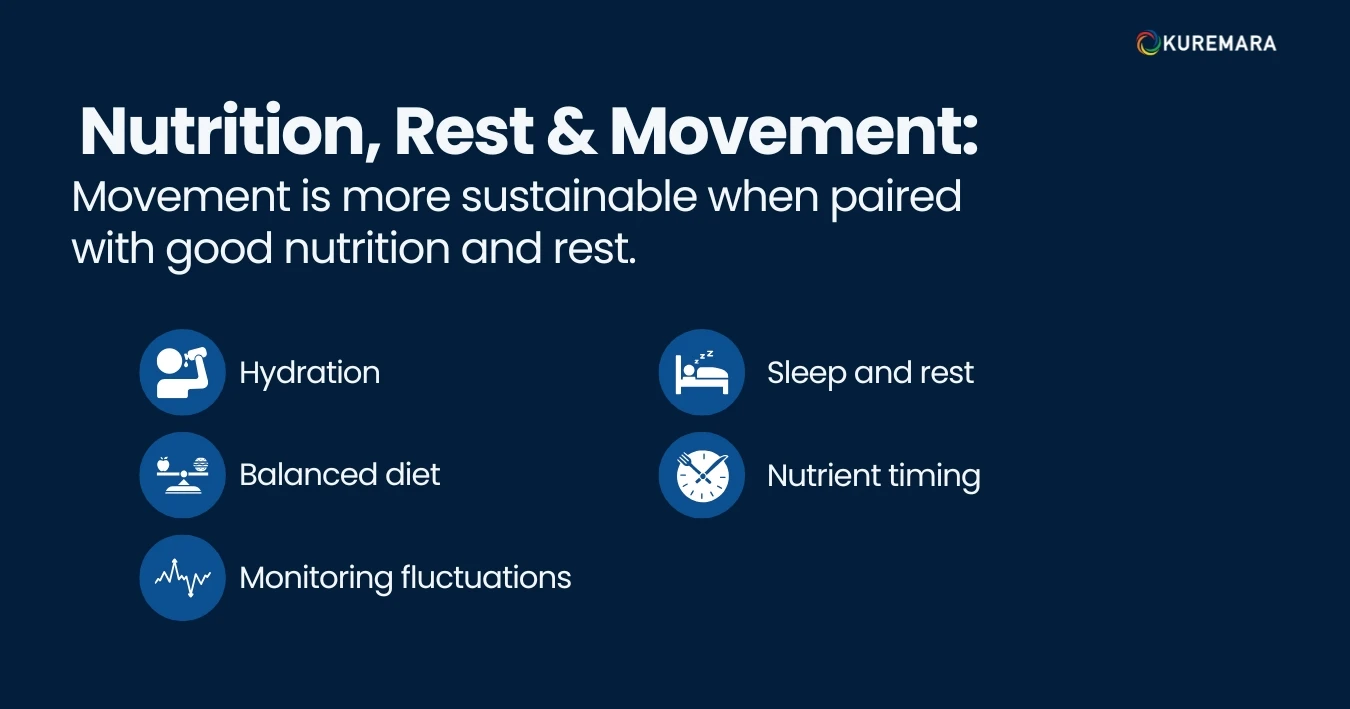
- Hydration matters – Dehydration can cause fatigue, muscle cramps, dizziness. Carers should monitor water intake closely.
- Balanced diet – Adequate protein, minerals (calcium, magnesium), and vitamins (vitamin D) support muscle recovery and energy.
- Sleep and rest – Muscles recover during rest; overscheduling movement without rest can lead to fatigue or injury.
- Nutrient timing – Light snacks before movement (e.g. banana, yoghurt) help sustain energy, if medically appropriate.
- Monitoring fluctuations – Carers should watch for signs of overexertion (pain, breathlessness) and adjust accordingly.
Kuremara carers monitor these aspects holistically ensuring movement is safe, sustainable, and effective.
Final Thoughts: Movement as Dignity, Joy & Independence
Movement isn’t about forcing older adults into strenuous exercise. It’s about giving them the freedom to move, engage, and reclaim parts of life often lost to immobility. Every step, stretch, or gesture counts.
With trained carers, gradual planning, a safe environment, and compassionate encouragement, movement becomes a tool of dignity, preservation, and joy.
If you’re seeking home care that doesn’t just assist, but empowers your loved one to stay active, safe, and engaged; explore Kuremara’s hourly visiting, complex care at home, respite and live-in care options today. Let us walk beside them, one gentle step at a time.
